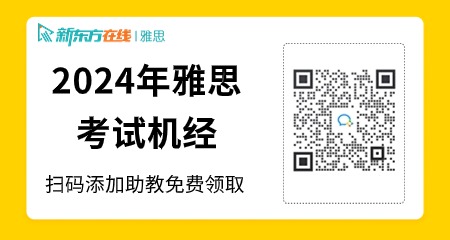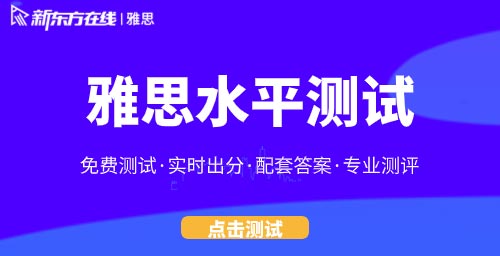2024.05.27 10:55
2024年5月25日雅思阅读考试已经结束,来和小编一起看看本场雅思阅读的题型和答案吧。
阅读
一、 考试概述:
本场考试三篇,两新一旧,难度高。第一篇人物传记,比较友好;第二篇延续上一场的睡眠话题,比较反常;第三篇农业话题,这个话题在今年已经考过2次了,难度高,考生们一定要注意累积相关词汇。
二、具体题目分析:
Passage One:
文章题材:说明文(人物传记)
文章题目:放射性碳年代测定——Nancy Athfield的生平介绍
文章难度:★★★
题型及数量:判断+填空
题目及答案:
Radiocarbon Dating-The Profile of Nancy Athfield
Have you ever picked up a small stone off the ground and wondered how old it was? Chances are, that stone has been around many more years than your own lifetime. Many scientists share this curiosity about the age of inanimate objects like rocks, fossils and precious stones. Knowing how old an object is can provide valuable information about our prehistoric past. In most societies, human beings have kept track of history through writing. However, scientists are still curious about the world before writing, or even the world before humans. Studying the age of objects is our best way to piece together histories of our pre-historic past. One such method of finding the age of an object is called radiocarbon dating. This method can find the age of any object based on the kind of particles and atoms that are found inside of the object. Depending on what elements the object is composed of, radiocarbon can be a reliable way to find an object's age. One famous specialist in this method is the researcher Nancy Athfield. Athfield studied the ancient remains found in the country of Cambodia. Many prehistoric remains were discovered by the local people of Cambodia. These objects were thought to belong to some of the original groups of humans that first came to the country of Cambodia. The remains had never been scientifically studied, so Nancy was greatly intrigued by the opportunity to use modern methods to discover the true age of these ancient objects.
Athfield had this unique opportunity because her team, comprised of scientists and filmmakers, was in Cambodia working on a documentary. The team was trying to discover evidence to prove a controversial claim in history: that Cambodia was the resting place for the famous royal family of Angkor. At that time, written records and historic accounts conflicted on the true resting place. Many people across the world disagreed over where the final resting place was. For the first time, Athfield and her team had a chance to use radiocarbon dating to find new evidence. They had a chance to solve the historic mystery that many had been arguing over for years.
Athfield and her team conducted radiocarbon dating of many of the ancient objects found in the historic site of Angkor Wat. Nancy found the history of Angkor went back to as early as 1620.According to historical records, the remains of the Angkor royal family were much younger than that, so this evidence cast a lot of doubt as to the status of the ancient remains. The research ultimately raised more questions. If the remains were not of the royal family, then whose remains were being kept in the ancient site? Athfield’s team left Cambodia with more questions unanswered. Since Athfield’s team studied the remains, new remains have been unearthed at the ancient site of Angkor Wat, so it is possible that these new remains could be the true remains of the royal family. Nancy wished to come back to continue her research one day.
In her early years, the career of Athfield was very unconventional. She didn’t start her career as a scientist. At the beginning, she would take any kind of job to pay her bills. Most of them were low-paying jobs or brief community service opportunities. She worked often but didn’t know what path she would ultimately take. But eventually, her friend suggested that Athfield invest in getting a degree. The friend recommended that Athfield attend a nearby university. Though doubtful of her own qualifications, she applied and was eventually accepted by the school. It was there that she met Willard Libby, the inventor of radiocarbon dating. She took his class and soon had the opportunity to complete hands-on research. She soon realised that science was her passion. After graduation, she quickly found a job in a research institution.
After college, Athfield’s career in science blossomed. She eventually married, and her husband landed a job at the prestigious organisation GNN. Athfield joined her husband in the same organisation, and she became a lab manager in the institution. She earned her PhD in scientific research, and completed her studies on a kind of rat in New Zealand. There, she created original research and found many flaws in the methods being used in New Zealand laboratories. Her research showed that the subject’s diet led to the fault in the earlier research. She was seen as an expert by her peers in New Zealand, and her opinion and expertise were widely respected. She had come a long way from her old days of working odd jobs. It seemed that Athfield’s career was finally taking off.
But Athfield’s interest in scientific laboratories wasn’t her only interest. She didn’t settle down in New Zealand. Instead, she expanded her areas of expertise. Athfield eventually joined the field of Anthropology, the study of human societies, and became a well-qualified archaeologist. It was during her blossoming career as an archaeologist that Athfield became involved with the famous Cambodia project. Even as the filmmakers ran out of funding and left Cambodia, Athfield continued to stay and continue her research.
In 2003, the film was finished in uncertain conclusions, but Nancy continued her research on the ancient ruins of Angkor Wat. This research was not always easy. Her research was often delayed by lack of funding, and government paperwork. Despite her struggles, she committed to finishing her research. Finally, she made a breakthrough. Using radiocarbon dating, Athfield completed a database for the materials found in Cambodia. As a newcomer to Cambodia, she lacked a complete knowledge of Cambodian geology, which made this feat even more difficult. Through steady determination and ingenuity, Athfield finally completed the database. Though many did not believe she could finish, her research now remains an influential and tremendous contribution to geological sciences in Cambodia. In the future, radiocarbon dating continues to be a valuable research skill. Athfield will be remembered as one of the first to bring this scientific method to the study of the ancient ruins of Angkor Wat.
Questions 1-7
Do the following statements agree with the information given in Reading Passage 1?
In boxes 1-7 on your answer sheet, write
TRUE if the statement agrees with the information
FALSE if the statement contradicts with the information
NOT GIVEN if there is no information on this
1 Nancy Athfield first discovered the ancient remains in Cambodia.
2 The remains found in the Cambodia were in good condition.
3 Nancy took some time off from her regular work to do research in Cambodia.
4 The Cambodian government asked Nancy to radiocarbon the remains.
5 The filmmakers aimed to find out how the Angkor was rebuilt.
6 Nancy initially doubted whether the royal family was hidden in Cambodia.
7 Nancy disproved the possibility that the remains belonged to the Angkor royal family.
Questions 8-13
Complete the flowchart below.
Choose ONE WORD ONLY from the passage for each answer.
Write your answers in boxes 8-13 on your answer sheet.
The Career of Nancy Athfield
During her mid-teens, Nancy wasn't expected to attend 8 ________ .
↓
Willard Billy later helped Nancy to find that she was interested in science.
↓
Her PhD degree was researching when a kind of 9 ________first went into New Zealand.
↓
Her research showed that the subject's 10 ________ accounted for the fault in the earlier research.
↓
She was a professional 11 ________ before she went back to Cambodia in 2003.
↓
When she returned Cambodia, the lack of 12 ________ was a barrier for her research.
↓
Then she compiled the 13 ________ of the Cambodia radiocarbon dating of the ancients.
↓
After that, the lack of a detailed map of the geology of Cambodia became a hindrance of her research.
参考答案
1. FALSE
2. NOT GIVEN
3. NOT GIVEN
4. FALSE
5. FALSE
6. NOT GIVEN
7. TRUE
8. university
9. rat
10. diet
11. archaeologist
12. funding
13. database
可参考真题:剑桥18—TEST4 Passage3 Alfred Wegener: science, exploration and the theory of continental drift
Passage Two:
文章题材:说明文(医疗健康)
文章题目:睡眠和记忆
文章难度:★★★★
题型及数量:段落信息匹配+填空+人名匹配
题目及答案:待补充
可参考真题:剑桥14—TEST4 Passage1 The Secret of Staying Young
Passage Three:
文章题材:议论文(科技类)
文章题目:农业运输交通进化
文章难度:★★★★
题型及数量:单选+摘要题(有选项)+判断
题目及答案:
Questions 27-30 单选
27. A
28. C
29. B
30. A
Questions 31-35 摘要题(有选项)
31. H
32. J
33. B
34. E
35. C
Questions 36-40 判断
36. NO
37. YES
38. NOT GIVEN
39. NO
40. YES
可参考真题:剑桥18—TEST1 Passage1 Urban farming
话题词:
1.auditorium 大礼堂
2.canopy 天幕
3.dwelling 住所
4.warehouse 仓库
5.villa 别墅
6.shelter 庇护所
7.vault 拱形圆屋顶;地窖
8.temple 庙宇
9.palace 宫殿
10.stall 摊位
同义替换词:
每期10组经典雅思阅读经典同义替换积累
1. wet - damp - moist 潮湿的
2. conviction - belief 信念,观点
3. exemplify - illustrate 是……的典型
4. interpretation - explanation 解释
5. longevity - life - life span - life expectancy 寿命
6. prone - inclined 易于遭受的
7. retrieve - recover - get back 取回
8. insight - inspiration 灵感
9. ethical - moral 道德的
10. eternal - everlasting 不朽的
点击查看》》》》》2024年5月25日雅思考试题答案汇总。
【2024年雅思考试机经-扫码添加助教免费领取】

【雅思免费试听课-0元领取】
【雅思水平测试-免费】

扫码添加助教号
免费获取最新雅思口语题库


